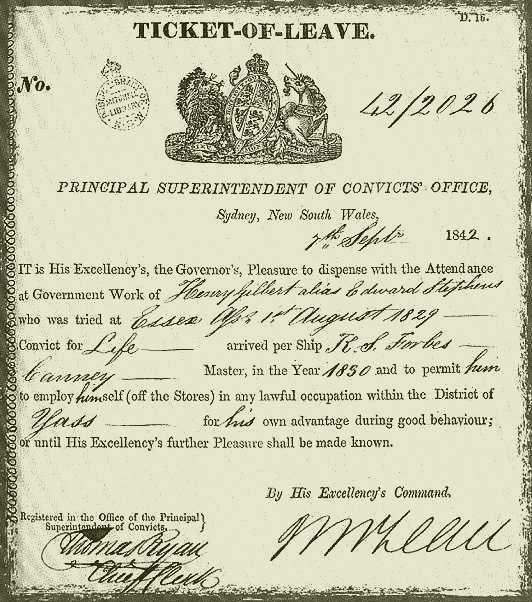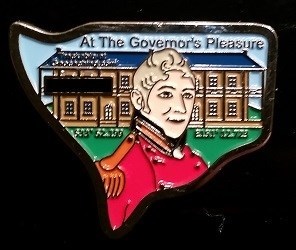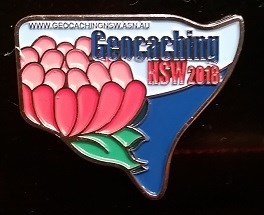At The Governor's Pleasure

Geocache Of The Year - 2017

Major-General Lachlan Macquarie
5th Governor of NSW
1810 - 1821
Just imagine you have been teleported back in time as a convict to the period when Major-General Lachlan Macquarie is the Governor of the penal colony of New South Wales. The year is 1818. You have been in NSW for the past seven years having been convicted of forgery and transported from your home in Kent, England. You travelled out on the convict ship, “Admiral Gambier” where life was cruel and punishments for the slightest infractions were harsh!

In the early part of your sentence, life was very hard. You worked on road building gangs and also in the construction of courthouses and hospitals. For the last three years, you have been in servitude to a wealthy land holder by the name of William Henry. He is a kind man and treated you well.
Over the past seven years, you have worked hard and kept your head down. You are now coming to the end of your sentence and you are hoping that you will be granted a......
Ticket-Of-Leave

This is a most prized document of parole and is issued to convicts who show they can now be trusted with some freedoms. You have heard that Governor Macquarie is a fair and just man and is willing to give those who deserve it, a fair go! You are hopeful that William Henry has put in a good word for you and that your Ticket-Of-Leave will be granted by the Governor. Back home, you were a printer so you would like to start a new life and business in the colony.
Governor Macquarie has heard of your efforts to reform and has given you one final task to perform. By successfully completing this task, he will grant you your Ticket-Of-Leave and therefore, your freedom!!
Your task is to travel around to various locations in Sydney Town and learn about the legacy of Governor Lachlan Macquarie. At each location, you will discover a clue word. Using the very simple A=1, B=2, C=3… Z=26 code, convert the clue word to a value by adding together the numbers that correspond to the letters in that word, eg TIME=20+9+13+5=47. The clue words will help you discover the next waypoint to visit. Please note that most waypoints are available 24/7 however a couple are only available duting business hours (7 days).
When you have visited all 14 waypoints, do the final calculations to work out Wp15's location where Goverrnor Macquarie has left you a final code word to discover. Enter this final code word into the Certitude checker below, to reveal the final coordinates to go to as well as the information needed to locate Macquarie's Chest containing your Ticket-Of-Leave and the Convict Logbook for you to sign.
To assist you in your task, Governor Macquarie has prepared a PDF worksheet that you can download. Standard Groundspeak Disclaimer: You are about to download a file that contains information that may help you to find this geocache. As the geocache owner, I represent that this file is safe to download although it has not been checked by Groundspeak or by the reviewer for possible malicious content. Download this file at your own risk.
At The Governor's Pleasure Worksheet (v16)
Five final points:
1. This multi has 15 waypoints and the final GZ for you to visit. Depending on how quickly you walk, how many other caches you look for along the way, how many coffee/food breaks you take and what extra sightseeing you want to do, completing this cache could take anywhere from 5 to 8 hours. Shorter if you bike ride.
2. Satellite reception at some locations in the city can be a bit dodgy. You may have to widen your search to find what you are looking for.
3. Check and double check all your calculations as you go.
4. If you require any help to verify you have the correct clue words and their values, please don't hesitate to contact me via my public profile.
5. If you are riding a bike, make sure you bring a bike lock with you.
Good luck with your task and I hope you will be granted your Ticket-Of-Leave.
**A special thank you to Mr Patrick Dodd, President of The Macquarie Society, for his valuable assistance in the development and placement of this geocache.
--------------------//O\\--------------------
Wp1 (Published Coordinates) – The Man
Here you will find a statue of the great man himself. This statue commemorates Governor Lachlan Macquarie's part in founding and shaping Sydney. It stands at the head of the magnificent street that bears his name and where many of Sydney's most important buildings were and are located. Macquarie was a British military officer and colonial administrator. He served as the last autocratic Governor of New South Wales from 1810 to 1821 and had a leading role in the social, economic and architectural development of the colony. He is considered by some historians to have had a crucial influence on the transition of New South Wales from a penal colony to a free settlement and therefore to have played a major role in the shaping of Australian society. An inscription on his tomb on the Isle of Mull, Scotland describes him as "The Father of Australia".
Look at the base of the statue.
A = the value of the second word, first line, beginning with "U"
Wp2 can be found at:
S33° 52.(A+105) E151° 12.(A+585)
Wp2 - I'm Innocent, Your Honour!!
One of Macquarie's first tasks when he became Governor was to restore orderly, lawful government and discipline in the colony following the Rum Rebellion of 1808 against his predecessor, Governor William Bligh. Through his work, Macquarie defined how the civil court system was to be structured. As far as possible, English law was to be followed. Macquarie's efforts to allow emancipists (ex-convicts) to become lawyers and appear before the Supreme Court was often blocked by Jefferey Bent, the first judge of the Colony of New South Wales.
Find a round, green plaque. King Elizabeth should help you if the coordinates are a bit dodgy.
B = the value of the last word, sixth line of text under the heading, beginning with "c"
Wp3 can be found at:
S33° 52.(B+76) E151° 12.(B+615)
Wp3 - Blessed Are The Meek
When Governor Macquarie arrived in the colony, he found that the morals of the inhabitants were in the "lowest state of debasement". It was felt that the establishment of churches and education was seen as a way to combat the issue. The nearby religious building was commissioned by Governor Lachlan Macquarie in 1819. It was designed by the convict architect, Francis Greenway, who had been sentenced to 14 years for forgery and transported to NSW. Ironically, Greenway's face was shown on the first Australian decimal currency $10 note (1966–93), making him probably the only convicted forger in the world to be honoured on a banknote. The building was originally intended to serve as a courthouse but the design was altered and a steeple was added at the western end. The first service was held in the unfinished church on the 6th January, 1822.
Bollards. Look down and find the plaque below the portrait.
C = the value of the last word, fourth line, beginning with "t"
Wp4 can be found at:
S33° 52.(C-4) E151° 12.(C+647)
Wp4 - Rum, Rum and More Rum
The hospital was one of the many public works projects completed by Governor Macquarie. He was denied the necessary finances to build it by the British Government so he struck up a deal with merchants Alexander Riley, Garnham Blaxcell and colonial surgeon, D’Arcy Wentworth. In exchange for being granted the sole import rights of 45,000 gallons of rum to the colony, these contractors built Macquarie’s hospital, which as a result, became popularly known as the ‘Rum Hospital’. The hospital south wing is now known as The Mint, and the north wing is the entrance to the NSW Parliament House.
Kiosk. Find the round Rum plaque on the footpath.
D = the value of the second word, fourth line of text under the star, beginning with "M"
Wp5 can be found at:
S33° 52.(D+28) E151° 12.(D+610)
Wp5 - Show Me The Money
In 1813, Macquarie introduced coinage to the colony. He purchased some Spanish silver dollars and punched out the centre thus creating two new coins. Another of Macquarie's innovations was the introduction of the colony's first bank in 1817, known as The Bank of New South Wales. Initially, Macquarie petitioned the British Government to allow him to start the bank. Correspondence to Britain took around six months to arrive, travelling by sailing ship and a further six months for Macquarie to receive an answer to his request. The British Government refused Macquarie's request but it was too late! The bank had already begun trading. To a large extent, Macquarie established our nation's economy, creating an environment in which commerce and manufacturing could flourish.
Macquarie gets around. Another statue, another plaque (not on the statue).
E = the value of the only word in brackets, beginning with "e"
Wp6 can be found at:
S33° 51.(E+774) E151° 13.(E-102)
Wp6 - Elizabeth's Way
Soon after the Macquarie’s arrived in Sydney town, the Governor began to develop an extensive network of roads in the area. One of these roads, Mrs Macquarie's Road, was built to allow access to the point for his wife, Elizabeth, who was Governor Macquarie's second wife. His first wife, Jane, died of tuberculosis in 1796, three years after they were married. Standing at this waypoint, you can imagine Elizabeth being conveyed by horse drawn carriage across this structure she designed over two centuries ago. Ignore the skyscrapers that tower over the hodgepodge of exotic trees and the fact that the shoreline was over 100 metres to the north. Picture instead what life was like in Sydney when building a few kilometres of road was a profound act of civilisation, and before any colonist had the slightest clue what lay on the other side of the Blue Mountains. Mrs Macquarie's Road once snaked from Old Government House through to Mrs Macquarie's Chair and was completed on June 13, 1816. History records that the craftsmanship of the convicts who built this structure was rewarded with five gallons of rum.
Find the information sign.
F = the value of the third word, fifth line of text under the title, beginning with "r"
Wp7 can be found at:
S33° 51.(F+464) E151° 13.(F+243)
Wp7 - Pull Up A Chair
Elizabeth loved to come here and enjoy the peace and serenity. She used to sit on the rock chair and watch for ships from England sail into the harbour. The chair was hand carved from sandstone by convicts.
Find the tall information sign.
G = the value of the third word, first line, third paragraph, beginning with "B"
Wp8 can be found at:
S33° 51.(G+348) E151° 12.(G+801)
Wp8 - Ready, Aim, Fire!!
Fort Macquarie was located on Bennelong Point where the Opera House now stands. Governor Macquarie directed that a fort be built for the protection of Sydney. This was built between December 1817 to February 1821 under the direction of architect, Francis Greenway. The fort was named after the Governor and was a square fort with circular bastions at each corner and a castellated square tower. Fort Macquarie was demolished in 1901 to make way for the building of sheds to house the new electric trams. This was named the Fort Macquarie Tram Depot. The tram depot continued to occupy the site until 1958 when it was demolished in preparation for the construction of the Sydney Opera House.
The coordinates take you to a raised bronze information board about the geometry of the Opera House "sails". Find the text written by Jorn Utzon, the architect of the Sydney Opera House.
H = the value of the last word, fourth line from the top, beginning with "s"
Wp9 can be found at:
S33° 51.(H+721) E151° 12.(H+747)
Wp9 - Giddy-up
Originally commissioned in 1815 as the stables for the proposed new Government House of New South Wales, the building was another designed by the convict architect, Francis Greenway. The castle-like building was described as a "palace for horses" and is a portrayal of the romantic vision of Governor Lachlan Macquarie and the British architectural trends of the time. The stables, located close to picturesque Sydney Harbour, reflect the building techniques and the range of materials and skills employed during the early settlement era.
Find the green circle.
J = the value of the first word, fifth line of text under the heading, beginning with "a"
Wp10 can be found at:
S33° 51.(J+695) E151° 12.(J+578)
Wp10 - The House On The Corner
The home of the first Governor of New South Wales, Captain Arthur Phillip, was a structure made of canvas and timber brought from England with the First Fleet and erected in January 1788. After establishing the site of the settlement, a substantial "temporary" government house was located on this corner. It was built under the direction of James Bloodsworth, a convict builder responsible for the construction of most of the colony's buildings between 1788 and 1800. This building, the first "permanent" building in Sydney, was completed by 1789 using some English bricks, local stone and a quantity of convict-baked sandstock bricks from the Sydney region.
This first government house was extended and repaired by the following eight governors. The house suffered as a result of the poor mortar (made from the lime of crushed sea shells), white ant infestations and what appeared to be rising damp in later years. Despite these problems, the house was an architectural milestone for Australia, and the first proportionately classical building on the continent. It even included Australia's first staircase.
The building was adapted quickly to the Australian climate. A verandah was added by Governor King around 1800, and a drawing room was added in a side wing in the same year. By 1816 Francis Greenway was commissioned by Governor Macquarie to construct a substantial extension and ballroom, transforming Phillip's house into an Italian style cottage.
Lachlan Macquarie was responsible for the construction of many of the colony's first permanent public buildings, and he attempted to build a replacement for the original Sydney Government House. Work on the new site was started by the convict architect Francis Greenway, but the project was not approved by the British Government, and only the castle-like stables, commissioned in 1816, were ever finished.
The house on this site was used until 1845, when the official residence of the Governor relocated to the present Government House, adjacent to the Botanic Gardens, where it is today. The old building here was demolished in 1845/46
Look closely here. You can still see remnants of the foundations of Phillip's original house.
Look for the information at the big slope where you can see the old foundations.
K = the value of the second last word, fourth line of text under the orange highlight, beginning with "b"
Wp11 can be found at:
S33° 51.(K+699) E151° 12.(K+522)
Wp11 - A Special Place
This location was the first formally laid out public space in Sydney (1810), functioning as the town square. Along with Hyde Park, it is the oldest public park in Australia. Its size has been greatly reduced since colonial days.
The obelisk is the earliest surviving public monument of Australia's colonisation. It was commissioned by Governor Macquarie and designed by Francis Greenway. Erected in 1818 (probably using convict labour), the large sandstone structure functioned as the zero point for the measurement of early roads in New South Wales and formed part of Governor and Mrs Macquarie`s civic improvements. The obelisk is supposedly erected on the site where Captain Arthur Phillip raised the Union Jack when the First Fleet arrived on the 26th January, 1788. The monument was also the ‘symbolic peg’ indicating the furthest extent of the British Empire in the early 1800s.
Later an anchor from the Norfolk Island wreckage of the First Fleet flagship, HMS Sirius, together with a cannon from the ship, were placed in the park.
Many important institutions have had establishments at Macquarie Place. In 1817 Australia's first bank, the Bank of New South Wales (later to become Westpac in 1982) opened in Macquarie Place. The State Library of NSW briefly had premises here during the 1830s. Opposite, in Bridge Street, is the original New South Wales Lands Department head office, which was the department responsible for the surveying and mapping of New South Wales.
Pointy thing.
L = the value of the last word, eighth line, beginning with "C"
M = the number of black, vertical bars surrounding the pointy thing
Wp12 can be found at:
S33° 51.(L+M+364) E151° 12.(L+M+389)
Wp12 - Row, Row, Row Your Boat
Built in 1816, this cottage is one of only a handful of Sydney buildings that remain from the first 30 years of the colony. Over the years, this sandstone cottage has been a water transport headquarters, a sailors' home and a water police station, among other things. It used to be located on the water's edge but since the construction of Circular Quay the harbour has 'moved' 100 metres away.
Find the information sign.
N = the value of the fifth word, third line, left paragraph, beginning with "c"
Wp13 can be found at:
S33° 51.(N+348) E151° 12.(N+390)
Wp13 - Nation Builders
It was Macquarie's treatment of convicts in his charge that earns continuing respect and admiration today. This was more than humanitarianism, it was nation-building. The colony needed a workforce, the larger the better. Macquarie believed that when a prisoner had discharged his debt to society, he should be "eligible for any situation which he has, by a long term of upright conduct, proved himself worthy of filling." Macquarie believed in the worth of all individuals. He offered them hope and encouragement and promoted self respect among the convicts. He gave all people a chance to share in the building of this nation. He did not distinguish between the free and the freed and gave all the opportunity to attain positions of trust and authority. In Macquarie's example of tolerance and humanity, we see the beginning of the notion of "a fair go for all", a value we in Australia still hold dear.
Find the Convict.
P = the value of the second word, first line of text, beginning with "d"
Wp14 can be found at:
S33° 51.(P+625) E151° 12.(P+557)
Wp14 - Wow! Look At Us!!
Lachlan Macquarie would have been proud to see what we have become today. He was a man of great vision. Re-establishing the rule of law was to be his first task in a 12-year term that would transform the colony from a dumping ground for convicts to a prosperous settlement. Macquarie steered the colony towards economic independence. He was instrumental in establishing Australia’s first bank and introducing its first currency, the Holey Dollar. He treated everyone with respect and fairness and believed that everyone, no matter your past, was worthy of a second chance. He established education as a priority. Macquarie embarked on a building program that is still very much evident today. He encouraged exploration to search for pastoral land to help make the colony self-sustaining. He established towns like Windsor, Richmond and Bathurst. His ideas on public health were visionary, establishing both ordinary hospitals as well as psychiatric hospitals. He had a great respect for the local indigenous people. Macquarie even decided which side of the road we would drive on!
The Sydney of today, indeed, our country as a whole owes a great debt to Governor Lachlan Macquarie. May his legacy live on in our hearts and minds.
The coordinates take you to the entrance. Go inside and look down.
Q = the Aboriginal word behind the docked cruise ship, beginning with "M"
Wp15 - Governor Macquarie's Final Code Word
Now use all the values you have calculated at waypoints 1 to 14 to discover the whereabouts of Governor Macquarie's Final Code Word. This code word, when entered into the Certitude checker below, will reveal the GZ coordinates and a coded message that will enable you to locate Macquarie's Chest as well as how to open it so you may sign the Convict Logbook and obtain your Ticket-Of-Leave. Macquarie's Final Code Word is located at:
S33° aa.bbb E151° cc.ddd
aa = (A+C+E+G+J+L+N+Q) - 796
bbb = (B+D+F+H+K+M+P) + 310
cc = (C+D+G+H+L+M+Q) - 709
ddd = (A+B+E+F+J+K+N+P) + 59
-------------------- << O >> --------------------
Here is a coordinate checker for Wp15. Hopefully, you've done all your calculations correctly and can move on to the final stage of your task.

Certitude Checker
Enter the Final Code Word you discover at Wp15 into the Certitude checker to receive the GZ coordinates and coded instructions to find Macquarie's Chest.

You can validate your puzzle solution with
certitude.
-------------------- << O >> --------------------

Geocaching NSW has released their 2018 geocoin highlighting "At The Governor's Pleasure". The geocoin features Governor Lachlan Macquarie on one side and the Geocaching NSW logo on the reverse side. Coins sell for $12 each and are available through their online shop. These geocoins are trackable through Geocaching.com.


-------------------- << O >> --------------------
He's done it again!!!

FTF Honours
Mr Everywhere - Bella at Waggy
FTFer Supremo!!
** Once you've completed this multicache, take a run out west for another fantastic multi, by TeamMerlin, that will further your education of Governor Lachlan Macquarie. You'll explore the historic town of Windsor, one of the five Macquarie Towns, located on the mighty Hawkesbury River. Check it out.....
GC6YXBY - On The Trail Of Macquarie

Did you know that NSW has a geocaching association? Geocaching NSW aims to enhance and improve the activity of geocaching and holds regular events where geocachers meet to enjoy their common interests. Visit the association website here.